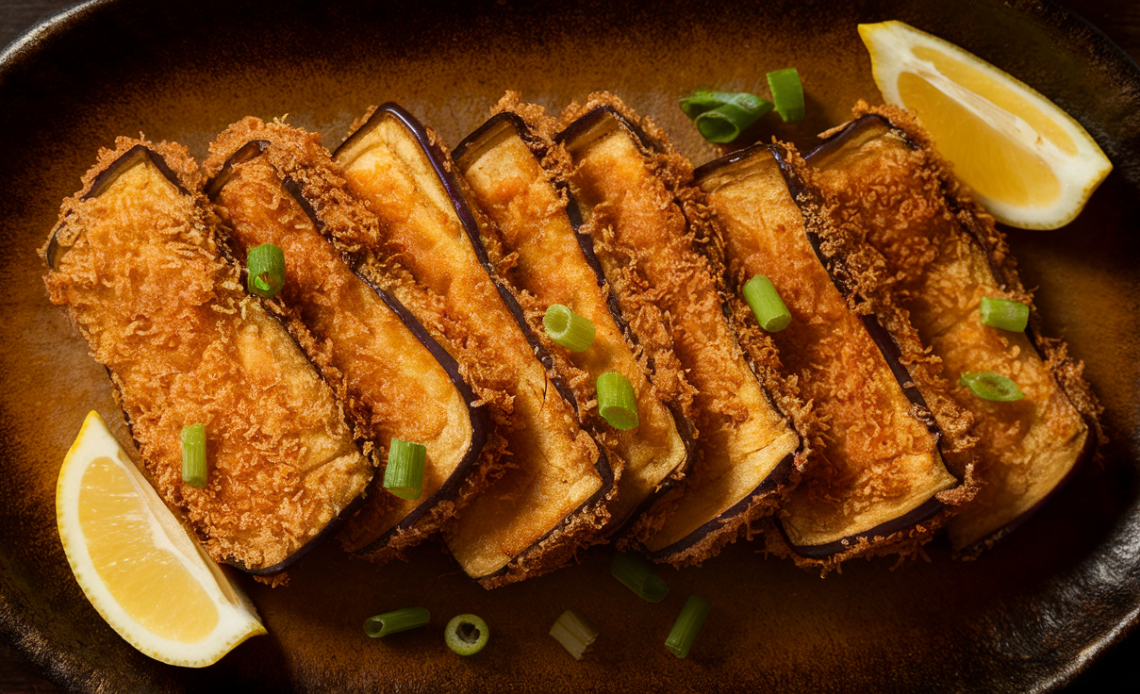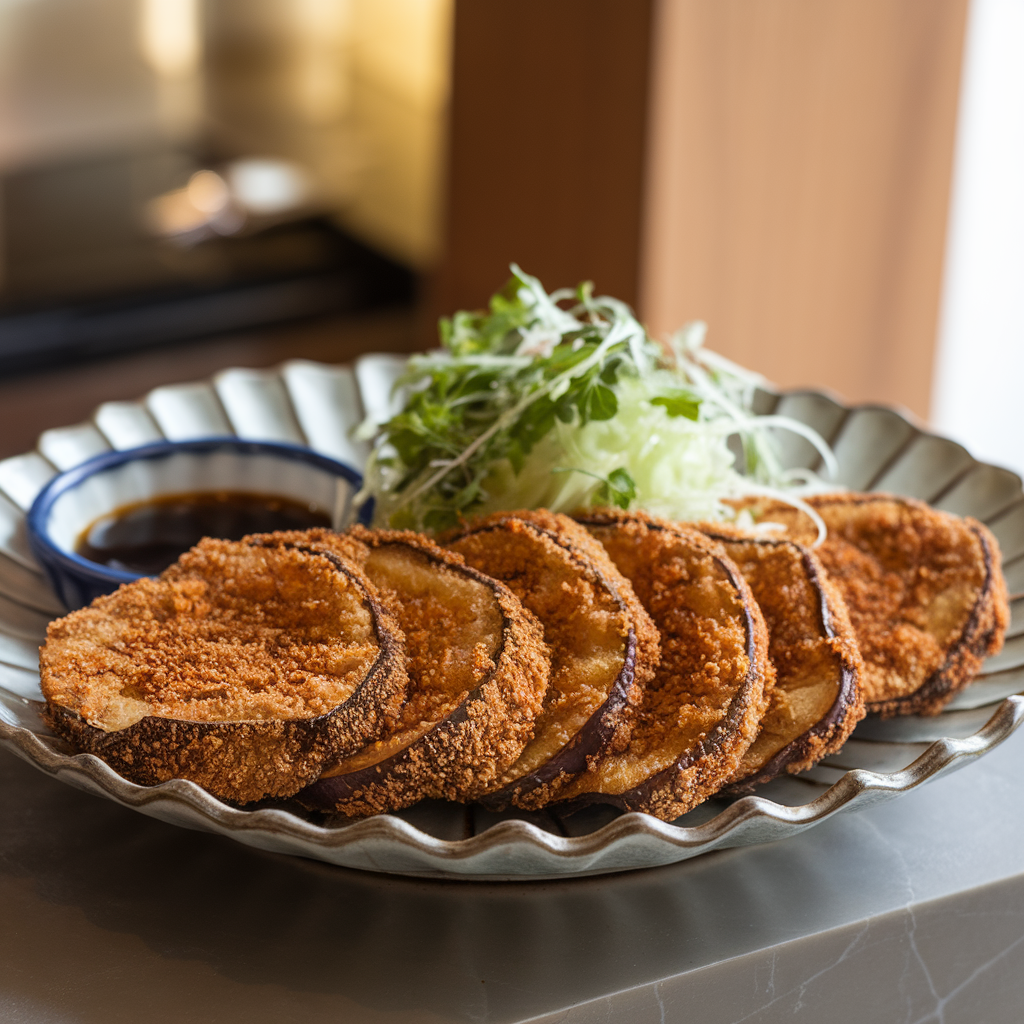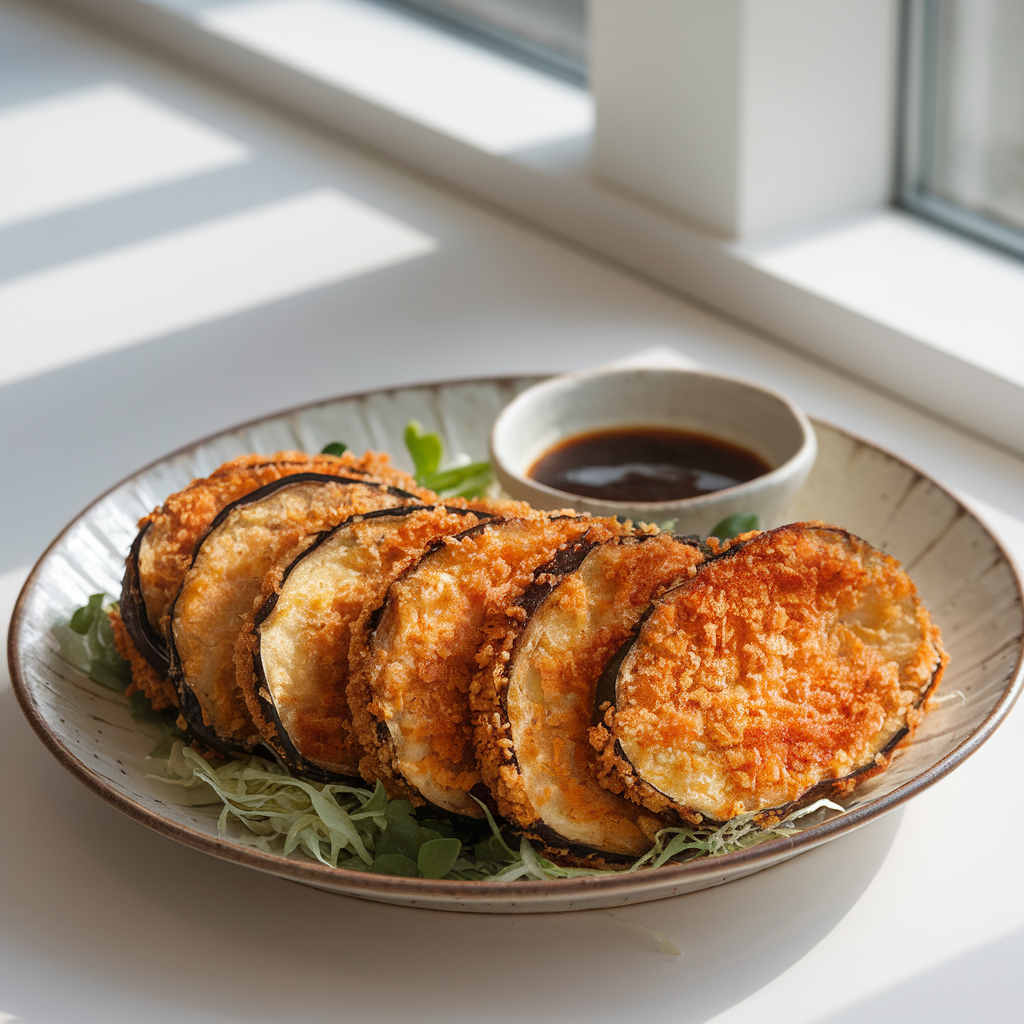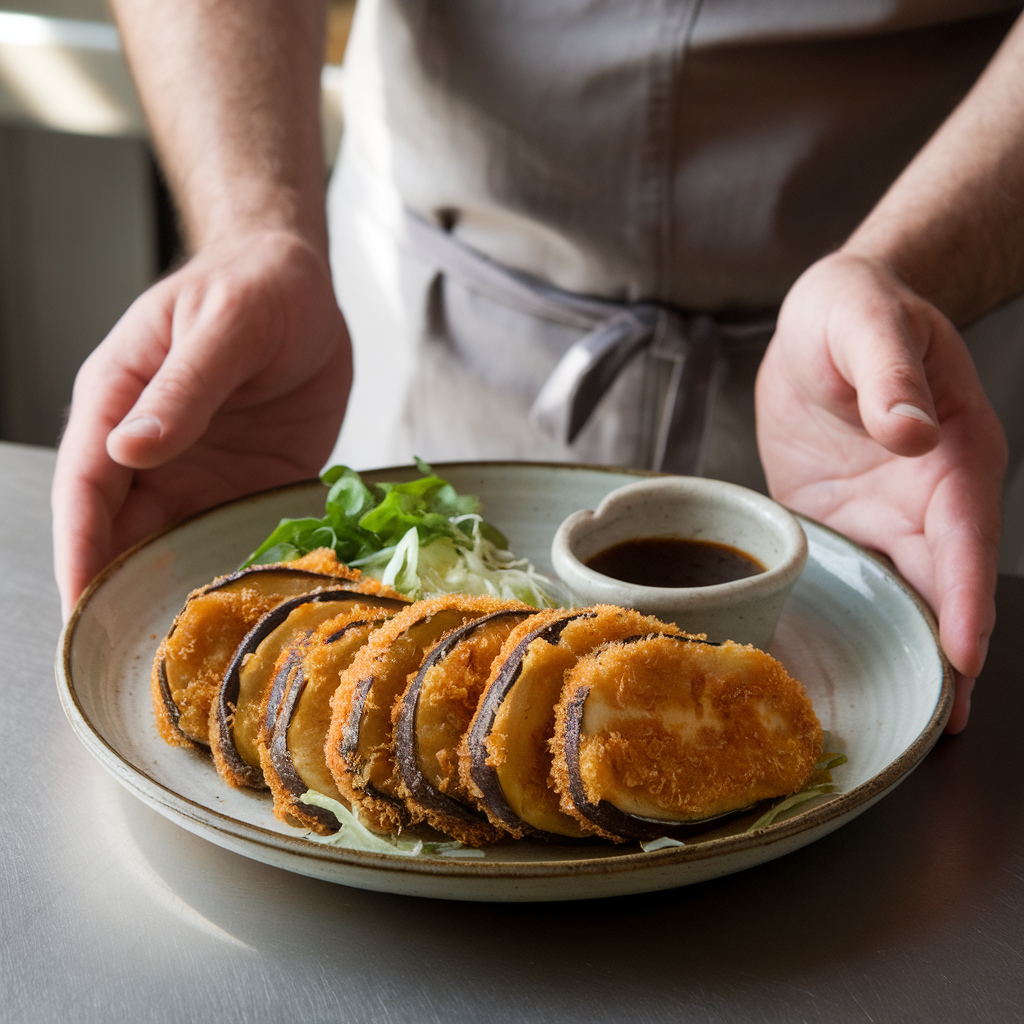
Eggplant (aubergine) is a superstar vegetable celebrated across cultures for its versatility, texture, and ability to soak up flavors. When transformed into a crispy crumbed delight inspired by Japanese katsu—traditionally a fried meat cutlet—eggplant becomes the centerpiece of a dish that’s equal parts crunchy, savory, and satisfyingly tender.
Whether you’re after egg plant fried recipes bursting with texture, crumbed eggplant recipes with a gourmet edge, or quick and easy vegetarian food ideas easy to make after a long day, this detailed guide covers everything you need to know to master Crispy Eggplant ‘Katsu’ with confidence and style.
The Essence of Katsu: Culinary Roots and Vegan Adaptation
“Katsu” derives from the Japanese word katsuretsu (cutlet), usually breaded and fried pork or chicken. The key hallmark is its panko crust—a type of Japanese breadcrumb that’s larger, airier, and lighter than Western breadcrumbs—yielding the iconic crispness.
As plant-based diets grow globally, chefs and home cooks alike have innovated to apply the katsu technique to vegetables, tofu, and mushrooms. Eggplant, with its naturally dense yet silky flesh, is one of the best vegetables to take on this role.
Transforming humble eggplant into golden, crunchy slices covered in seasoned panko breadcrumbs delivers all the indulgence of fried food, with none of the animal products—perfect for vegans, vegetarians, and anyone who loves vegan gourmet dinner ideas.
Ingredient Deep-Dive: What Makes This Recipe Tick?
1. Eggplant Selection and Preparation
- Choosing the right eggplant: Look for medium-sized, firm, shiny, deep purple eggplants with no soft spots or blemishes. Larger eggplants can be more seedy and bitter.
- Cutting: For even cooking, slice eggplants into uniform pieces, about 1/2 inch (1.3 cm) thick. You can cut rounds or lengthwise planks, depending on your serving idea.
- Salting: Salting draws out bitter compounds (phenolics) and excess water, improving texture and flavor. This degorging step is essential for eggplant recipes crispy success. Be patient—give it 20–30 minutes, then pat dry to avoid soggy coating.
2. Flour or Chickpea Flour for Breading Base
- Flour coats the eggplant to help the batter stick.
- Chickpea flour is a brilliant gluten-free and protein-rich substitute with a slight nutty flavor that pairs well with eggplant.
3. Vegan Wet Batter: Plant-Based Milk + Acid
- Unsweetened soy milk or oat milk work best because of their creamy texture.
- Add a tablespoon of apple cider vinegar or lemon juice to acidify the milk, mimicking buttermilk’s tang and helping the coating adhere better.
4. Panko Breadcrumbs: Crunch Masters
- Panko’s unique flaky texture absorbs less oil, delivering crispness without greasiness.
- Seasoning the panko with garlic powder, smoked paprika, black pepper, or even nutritional yeast adds depth.
5. Frying Oil and Temperature Control
- Use a neutral oil with a high smoke point (canola, vegetable, refined coconut).
- Maintain oil at 350–375°F (175–190°C). Use a thermometer if possible.
- Proper temperature prevents the crust from absorbing excess oil and ensures a golden crust.

Detailed Cooking Process with Expert Tips
Step 1: Salting and Resting Eggplant for Maximum Crispiness
- Arrange eggplant slices on a baking rack or paper towels.
- Salt generously on both sides.
- Let sit uncovered for 20–30 minutes.
- Blot moisture off with fresh towels. Moisture is the enemy of crispiness.
Pro tip: This step reduces oil splatter and improves the final texture. Don’t skip or rush!
Step 2: Breading Setup – The Three-Step System
- Station 1: Flour or chickpea flour. Sift for an even coat.
- Station 2: Vegan batter—whisk plant milk + vinegar until slightly thickened.
- Station 3: Seasoned panko breadcrumbs. Mix well for flavor balance.
Pro tip: For extra crunch, double-dip: flour → batter → panko → batter → panko.
Step 3: Bread Your Eggplant Like a Pro
- Dredge eggplant slices lightly in flour, shaking off excess.
- Dip in wet batter until coated.
- Press firmly into panko mixture on all sides to create a thick crust.
- Lay coated slices on a tray before frying.
Step 4: The Art of Frying
- Heat oil in a heavy-bottomed skillet or frying pan to 350°F (175°C).
- Fry eggplant in batches without crowding to maintain oil temperature.
- Cook about 3-4 minutes per side until deep golden.
- Remove and drain on paper towels to absorb excess oil.
Pro tip: Keep a thermometer handy; oil that’s too cool = greasy coating, too hot = burnt crust, undercooked interior.
The Tonkatsu-Style Sauce: Bringing It All Together
No katsu dish is complete without a tangy-sweet dipping sauce.
Ingredients:
- 1/4 cup ketchup
- 2 tbsp soy sauce or tamari (gluten-free option)
- 1 tbsp maple syrup or brown sugar
- 1 tsp Dijon mustard
- 1 tbsp rice vinegar
Preparation:
Whisk all ingredients until smooth. Adjust sweetness or acidity to taste.
This sauce complements the crispy eggplant with umami richness and brightness.

Advanced Variations and Flavor Boosters
Flavorful Crumb Mix-Ins
- Sesame seeds: Add 2 tbsp toasted sesame seeds to panko for nutty crunch.
- Nutritional yeast: 2 tbsp for cheesy, savory notes.
- Herbs: Finely chopped parsley, basil, or shiso leaves.
Spicy Kick
- Add chili powder, cayenne pepper, or smoked paprika to the crumb mixture.
- Serve with a vegan spicy mayo (vegan mayo + sriracha).
Alternative Coatings
- Mix ground nuts (almonds, cashews) with panko for a richer texture.
- Use gluten-free rice flakes mixed with panko.
Cooking Alternatives: Baking and Air Frying
For a lighter vegan fried eggplant option:
- Air Fryer: Preheat to 375°F (190°C). Lightly spray the crumbed eggplant slices with oil. Air fry 12–15 minutes per side until golden and crisp.
- Oven Bake: Preheat oven to 400°F (200°C). Place coated slices on a baking tray lined with parchment paper. Spray with oil. Bake 20–25 minutes, flipping halfway.
While frying delivers the crispiest result, air frying and baking are excellent healthier alternatives that still achieve satisfying crunch.
Serving and Presentation: Turn This Dish Into a Gourmet Experience
Simple Serving Ideas:
- On a bed of steamed white or brown rice with steamed bok choy or spinach.
- Wrapped inside a crusty vegan katsu sandwich with shredded cabbage and vegan mayo.
- Alongside pickled vegetables and a fresh cucumber salad.
Gourmet Dinner Setup:
- Plate with a side of sautéed shiitake mushrooms and garlic.
- Drizzle tonkatsu sauce artistically on the plate.
- Garnish with microgreens or sliced scallions.
- Pair with miso soup or a clear vegetable broth.

Nutrition Breakdown and Health Benefits
Per serving (approximate for 3 slices fried):
- Calories: 220–280 kcal (depending on frying oil amount)
- Protein: 5g (from chickpea flour and eggplant)
- Fiber: 5g (eggplant skin and flesh)
- Fat: 15g (mostly from frying oil)
- Carbohydrates: 18g
Why It’s Healthy:
- Eggplants provide antioxidants such as nasunin, which protects brain and heart health.
- Fiber promotes gut health and satiety.
- Using plant-based milk and flour makes it accessible for lactose intolerance and vegan diets.
- Balanced portioning keeps fat intake moderate.
Troubleshooting Common Issues
| Issue | Cause | Solution |
|---|---|---|
| Soggy coating | Eggplant too wet or skipped salting | Salt eggplant, blot dry, and maintain oil temp |
| Oil absorbs too much | Oil temperature too low | Use thermometer; keep oil hot but not smoking |
| Coating falls off | Not enough flour or wet batter | Ensure proper three-step breading; press crumbs well |
| Eggplant bitter | Not salted or too old | Always salt and rest; use fresh eggplants |
Cultural and Culinary Context: How Crispy Eggplant ‘Katsu’ Fits Into Global Vegetarian Food Ideas
In recent years, eggplant recipes crispy and vegan fried eggplant recipes have surged in popularity as more people seek flavorful plant-based options that satisfy cravings for crunchy, savory foods.
Japanese cuisine’s elegance and simplicity lend themselves beautifully to this fusion. The crispy crumb coating is a crowd-pleaser worldwide, and eggplant’s meaty texture makes it a vegan’s answer to fried chicken cutlets or schnitzels.
This dish represents the future of accessible, flavorful, and nutritious plant-based cooking—quick enough for weeknights yet refined enough for dinner parties.
How to Store, Reheat, and Enjoy Leftovers
- Store cooled eggplant katsu in an airtight container in the fridge for up to 2 days.
- To re-crisp, avoid microwaving. Instead, reheat in a toaster oven or air fryer at 350°F (175°C) for 5–7 minutes.
- Leftover eggplant katsu works wonderfully cold in sandwiches or salads.
Final Thoughts: Why This Recipe Will Become Your Go-To
The magic of crispy eggplant ‘katsu’ lies in its textural contrast—crispy, golden exterior and tender, creamy inside—combined with a tangy, umami-rich dipping sauce. It’s quick, versatile, and caters to a range of diets, ticking boxes for vegetarian quick recipes, vegetarian food ideas easy, and vegan gourmet dinner occasions.
It’s an approachable way to get creative with eggplant recipes Japanese style while keeping things simple, flavorful, and healthy.
Try it once and watch this recipe become a staple, impressing vegans and omnivores alike with its crunchy goodness and rich flavors.




